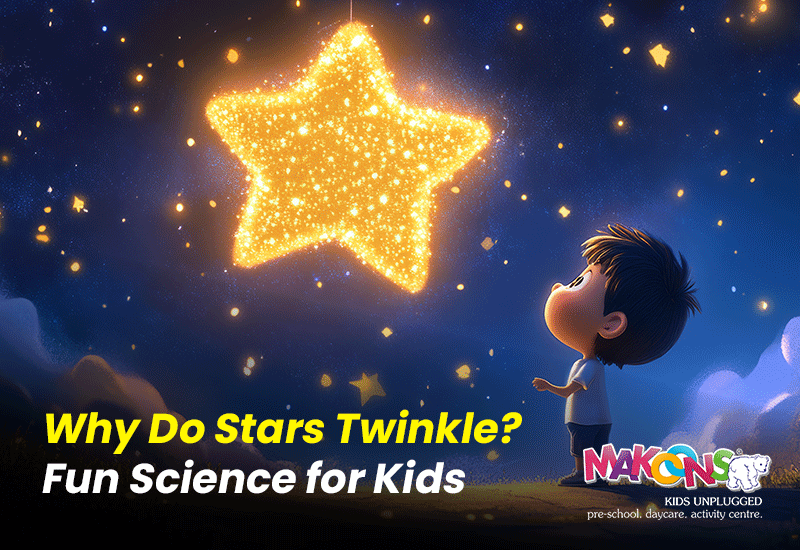Imagine witnessing hundreds of glittering lights dancing above you when you glance up at the nighttime heavens. For thousands of years, stars have captured the human spirit with an almost mystical glow. When stars seem to flutter and glow, though, what is happening?
Have you ever seen the celebs shimmer and dance while looking at the night sky? Though they seem like little magic acts performed far above our heads, those sparkling lights have a really amazing scientific explanation for why stars seem to glitter!
The Star Light Journey
Imagine stars as massive, fiery balls of light millions and millions of miles from Earth. These amazing cosmic light bulbs are so far apart that their light must travel an astonishing distance to reach our eyes. Here’s where things get interesting, though; that trip is not as straightforward as you may expect!
Earth’s Atmosphere: The Great Light Bender
Something called our atmosphere causes the sparkling effect. Consider the atmosphere as a gigantic, invisible ocean of air encircling our Earth. Like water flows and ripples when you blow on its surface, this layer of air is always shifting, whirling, and changing.
Starlight bends and twists in all kinds of directions when it moves through this shifting air. It’s like a straw twisted in a glass of water. Various air currents, temperatures, and wind patterns all force and pull the light. These small motions cause the light of the star to hop about, producing that wonderful sparkling effect seen from below.
Not All Lights Twinkle the Same Way
For youngsters, here is a fascinating star fact: Usually, planets shine less than stars do! It’s most likely a planet if you spot a tremendously brilliant “star” that seems constant and does not flicker. Planets are far closer to us, hence our atmosphere’s dispersion of their light is less.
The Science Behind the Sparkle
Let us dissect the events in a manner that makes sense.
- Super brilliant light sources millions of kilometres distant are stars.
- Their light must pass layers of flowing air in our atmosphere.
- The shifting, moving air bends the light.
- This bend creates a sparkling effect from the Earth.
A Closer Look at Atmospheric Conditions
Temperature variations can influence star twinkling intensity. Stars seem more consistent on a quiet, clear night. They will dance and flutter, especially more on a windy or chaotic night! The starlight is striving to flow through the atmosphere like a vast, invisible glass of moving water without becoming overly distorted.
Astronomers and Twinkling Stars
Astronomers and scientists have some quite ingenious approaches to handle star blinking. Researchers’ telescopes are sometimes positioned in exceptionally stable air conditions, such as those of high mountains or perhaps in space. There is no air distortion to concern space telescopes like the Hubble!
Fun Experiment for Young Scientists
Would you like to observe light bending? Try the basic experiment shown here:
- Slosh a transparent glass with water.
- Halfway in the water, put a pencil.
- See how the pencil seems to bend or shatter at the air’s meeting with the water.
This reminds me of how starlight curves as it passes through Earth’s air.
Star Twinkling Myths Busted
Though some children believe stars flutter like a candle, this is not true. Massively stable balls of blazing gas are stars. The twinkling is entirely related to the way their light passes through our atmosphere.
Why This Matters?
Though it seems like only fascinating trivia, knowing why stars twinkle is actually vital science. By examining how light moves and bends, scientists gain more knowledge about our environment, light, and the incredible world we live in.
Final Stellar Thoughts-
Stars: Nature’s Cosmic Night Lights
Stars have individual histories and are like nature’s own night lights beyond Earth. Some stars are tiny and red; others are enormous and blue. Long before people gazed up to wonder about them, they have been glittering in our heavens for billions of years.
A Universal Wonder
The flashing of stars reminds us of how wonderful our planet is, not only of aesthetic appeal. Every time you watch a star flutter, you are seeing a complex dance of light, air, and distance occurring right overhead. The universe seems to be staging a unique light display just for you!
Stargazing Tips for Young Astronomers
Want to master star-watching techniques? These are some intriguing ideas:
- Locate a dark spot free of city lights.
- Find constellations with a star chart or astronomy software.
- Bring a cosy blanket and back off.
- Patiently let your eyes grow used to the darkness.
- Search for planets; they don’t glitter! Also, search for variations in star colours.
Conclusion
Understanding why stars twinkle is just the beginning of exploring the amazing world of astronomy. It teaches us about light, atmosphere, and the incredible journey that light takes to reach our eyes. Every twinkle is a reminder that science is full of wonder and mystery.
Who knows? The curiosity you feel when looking at twinkling stars might be the first step towards becoming an astronomer, physicist, or space explorer. Some of the greatest scientists started just like you – by looking up at the night sky and asking, “Why?”
So, young explorers, the next time someone asks you, “Why do stars twinkle?” you’ll be ready with a scientific explanation that’s out of this world! Remember, every star has a story, and you’ve just learned how to read the first chapter of that incredible cosmic tale!
Also Read – Easy and interesting science questions for kids with answers

